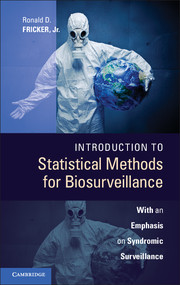Book contents
- Frontmatter
- Content
- Preface
- Acknowledgments
- Part I Introduction to Biosurveillance
- Part II Situational Awareness
- 3 Situational Awareness for Biosurveillance
- 4 Descriptive Statistics for Comprehending the Situation
- 5 Statistical Models for Projecting the Situation
- Part III Early Event Detection
- Part IV Putting It All Together
- Part V Appendices
4 - Descriptive Statistics for Comprehending the Situation
from Part II - Situational Awareness
Published online by Cambridge University Press: 05 March 2013
- Frontmatter
- Content
- Preface
- Acknowledgments
- Part I Introduction to Biosurveillance
- Part II Situational Awareness
- 3 Situational Awareness for Biosurveillance
- 4 Descriptive Statistics for Comprehending the Situation
- 5 Statistical Models for Projecting the Situation
- Part III Early Event Detection
- Part IV Putting It All Together
- Part V Appendices
Summary
…while the individual man is an insoluble puzzle, in the aggregate he becomes a mathematical certainty. You can, for example, never foretell what any one man will do, but you can say with precision what an average number will be up to. Individuals vary, but percentages remain constant. So says the statistician.
Sherlock Holmes in The Sign of Four (Sir Arthur Conan Doyle, 1890)The purpose of summary statistics is to take a mass of raw data and condense it in some useful manner. With biosurveillance, the goal is to facilitate an understanding of some aspect of the biosphere. In terms of situational awareness (SA), biosurveillance systems must summarize the data in ways that facilitate an understanding of historical trends, the current state, and how the current state compares with historical trends. That is, as the chapter title says, they must effectively display the situation for the decision maker.
Whereas medical practitioners operate at the individual datum level, meaning they see the biosphere one patient at a time, the point of biosurveillance is aggregation of data in order to see events that may not be evident at the individual level. In terms of early event detection (EED), both views are necessary for effective biosurveillance because some types of events are best detected on a case-by-case basis by individual medical practitioners, and other types of events are best detected in the aggregate.
- Type
- Chapter
- Information
- Introduction to Statistical Methods for BiosurveillanceWith an Emphasis on Syndromic Surveillance, pp. 67 - 110Publisher: Cambridge University PressPrint publication year: 2013



